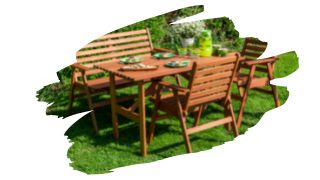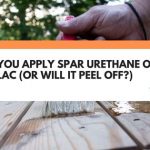Shellac is just one of a handful of natural wood finishes that have managed to stand the test of time.
For centuries, this glossy resin has been applied as a furniture finish. And it’s still used today, because of its ability to enhance the look of any surface.
And yet, despite its popularity as an interior wood finish, shellac rarely gets recommended as a sealer for exterior timber. But, why is that?
Well, in this post, you’ll learn what shellac is really made from. You’ll also discover what you need to look for in a quality outdoor furniture sealant.
And we reveal whether or not a shellac finish can truly safeguard your garden furniture.

This post may contain affiliate links to products that we receive a commission for (at no additional cost to you). Learn more here.
What Is Shellac?
Shellac is a natural resin that comes from lac bugs native to Thailand and parts of India.
It’s used in everything from wood finishes to nail polish, and even confectionery. Yet, as a wood finish, dried shellac flakes are thinned by adding high proof alcohol to them.
The alcohol dissolves shellac, making it a smooth liquid that you can easily apply onto wood. And as the alcohol evaporates away afterward, the shellac left behind forms a glossy (but brittle), top coat.
Related Post: Can You Really Apply Wood Wax Over Shellac? (Best Practice Revealed!)
Aren’t Waxed Shellac And Dewaxed Shellac Pretty Much The Same Thing?
Almost. You see, shellac is naturally waxy. And a waxed shellac finish is so slippery that its next to impossible to top coat it with anything.
But, dewaxed shellac is simply regular shellac, yet all of it’s wax has been removed. As a result, dewaxed shellacs look visibly clearer than their waxed shellac counterparts.
What’s more, dewaxed shellacs are very sticky — the complete opposite of waxed shellac.
You can apply dewaxed shellac onto most anything, from wood to concrete, and it will stick and stay. And most top coating sealants and finishes will adhere over a dewaxed shellac finish.
Related Post: Thinning Shellac With Mineral Spirits Won’t Work (Here’s What Will)
Does Shellac Waterproof Wood?
No, shellac isn’t waterproof. It is water-repellent, (up to a point), thanks to its natural waxiness.
Nevertheless, shellac is in fact a very poor choice sealant if you want to protect wood from water damage.
Also, shellac is very brittle, and is easily scratched. Alcohol will damage this finish, and even water can blemish it. Plus certain soaps, (especially ones that contain ammonia), can wreck a shellac finish to boot.
Honestly, the only real advantage to using shellac as a sealant, is that it’s fairly easy to spot-repair it.
Related Post: Can You Apply Shellac Over Varnish? (Best Practice Revealed!)
But Can You Use Shellac On Outdoor Furniture?
Shellac is a very, very poor option for outdoor furniture, for three good reasons;
1). It Is Not Waterproof
Rain and humidity will wreck that shellac coat within a matter of days. Even a light morning due will end up damaging this finish.
If water settles atop shellac, within a few hours, this finish will begin to show signs of water-damage.
2). It Is Not Weatherproof
If you want to seal outdoor furniture, you need to use a sealant that is more than just water-resistant. It needs to be weatherproof too.
In other words, an outdoor sealant ideally needs to include UV additives to help combat oxidizing UV rays. And an additional fungicide ingredient wouldn’t go amiss either (to prevent the growth of mold and mildew).
And shellac finishes have neither of these additives in them.
3). It Is Not Durable
An outdoor sealant needs to be a little bit flexible and hard-wearing.
You see, changes in humidity can cause wood to shift around. So, not only must an outdoor sealant be scratch-resistant, it also needs to have some ‘give’ to it too.
And shellac is far from a flexible finish.
So, What Kind Of Finish Is Suitable For Outdoor Furniture?
One of the most water-resistant weatherproofing sealants is Spar Varnish. Also known as Spar Urethane, this sealant waterproofs so well, that its used on boats and other marine vessels. And this sealant also includes UV inhibitors strong enough to protect wood from color fading.
It is a very thick finish, so you won’t need to apply much more than a couple coats to get full coverage. Essentially, Spar Urethane is durable, flexible, low maintenance, and it only needs to be reapplied once every 5 years.
If a Spar Urethane finish sounds right for you, then the best one on the market is Rust-Oleum’s Oil-Based Ultimate Spar Urethane.
Their clear oil-based Spar Urethane finish dries in under 2 hours. And it can be used on every type of exterior wood, from garden furniture, to garden fencing.
You can check out the latest prices for Rust-Oleum’s Spar Urethane right now on Amazon.
To Wrap Up, Here Are The 3 Key Takeaways From This Post…
- 1). Shellac is a natural wood finish that forms a fairly water-repellent hard coat.
- 2). But, shellac is not waterproof, and it is too brittle to be used as an outdoor finish.
- 3). Instead, a better choice would be to use Spar Urethane to seal outdoor furniture. This waterproofing finish will protect wood from rain, sun-damage and mold.
References:
Derrick, Michele R., et al. “Furniture finish layer identification by infrared linear mapping microspectroscopy.” Journal of the American Institute for Conservation 31.2 (1992): 225-236.



![Why Are There Bubbles In My Shellac Wood Finish? [+ How To Get Rid Of Them] bubbles in shellac wood finish](https://www.thewoodworkplace.com/wp-content/uploads/2022/10/Banner-499-150x150.jpg)